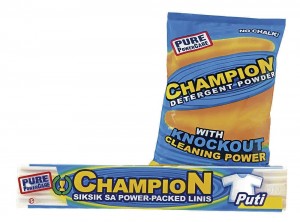Champion laundry detergent has been around for a while. The brand was launched with very little fanfare, if there was any, in 1997 and has since made its way into the hearts of millions of Filipino consumers, even without mainstream advertising.
From the very start, Peerless Products Manufacturing Corp.—the maker of Champion—focused on winning the trust of Filipino consumers by addressing their need for quality products at affordable prices.
It invested heavily in technology, research and development and its people.
Peerless uses one of the best European detergent making technologies, which costs double that of the ordinary technology, but guarantees efficient performance and quality output.
The first Champion production plant was built in Bulacan.
Peerless opted to grow slowly but surely, establishing its presence and ensuring a strong foothold first in the provinces before venturing into Metro Manila and the rest of the country.
“We also intentionally limited ourselves to selected provincial markets at the start because we knew that the capacity of our only factory then would not be enough to support the demand of a national market, we did not want to disappoint the consumers,” Peerless vice president for sales and marketing Jasper Tiu explains.
Brand identity
With the homegrown brand already established in these selected provincial markets and the second factory (in Laguna) already built, Champion entered Metro Manila and went nationwide in 2002.
The second plant, according to Tiu, beefed up capacity to a level that was enough to serve a national market.
Its strategy paid off. The brand was warmly received in Metro Manila and other markets.
Champion is now one of the top three laundry detergent brands in the country, accounting for about 20 percent of the market.
Despite an already strong following, Peerless knows Champion has to move with the changing times, especially with competition getting tougher.
The company, which in the past opted to do its business as quietly as possible, has started taking a more active position in marketing and advertising.
Peerless is now bent on establishing a strong brand identity that will enable more households to identify with Champion’s attributes.
It got itself brand ambassadors deemed best suited to represent Champion—Susan Roces, the queen of Philippine cinema; host Ryan Agoncillo and TV personality turned congresswoman Lucy Torres-Gomez.
Roces, according to the company, stands for the brand’s uncompromising quality and rich heritage; Agoncillo articulates Champion’s features and unique composition, while Torres-Gomez represents today’s women who look for innovations in the products they use.
Champion advertisements became highly visible. The products are now prominently displayed in the shelves of groceries and supermarkets.
“We are doing it not just for the sake of advertising. We advertise because we have a message to tell our consumers. We want them to know what they are buying and, in so doing, we empower them to choose which products to buy,” he says.
Empowering consumers
Tiu says there are no promotional gimmicks—such as giveaways or price discounts—for those will only eat up funds that the company uses now for continuing research and product improvements. Ad spending is, in fact, only a fraction of what competitors are spending.
“We tell the consumers that when they buy Champion, they are buying not only our laundry detergents but our commitment to make only quality products that they can afford,” he says.
“We tell them that they can trust us as we will never compromise the quality of our products. We also try to convince them not to compromise on the quality of detergents they buy.”
Tiu says Champion has been above other brands in terms of consistency, quality and overall care for the users’ hands and clothes, and the prices are easy on the pocket.
He describes Champion as a premium brand with a semi premium price. “We are not the cheapest in the market but we are affordable. The price factor is a qualifier but it does not guarantee success,” he says.
Even the cheapest products will not sell if the quality is poor, he says. “Filipino consumers across all segments are smart and discerning when it comes to their laundry detergents. This is what guides us in making business decisions.”
Affordability, quality
When it was starting, there were no market research or studies made but it was clear to the founders of Peerless—mostly mechanical and chemical engineers—that quality, combined with affordability, will make the business succeed. Thus, it did not commence commercial production until it had the best possible laundry detergent technology in place.
To make its products affordable, the company brought down its costs by producing its own primary raw materials, particularly the surfactants. This did not only enable the company to minimize costs, it also ensured that the quality of its raw materials would not be compromised and that supply and delivery would not be a problem.
“We are confident we have the best possible products in the market.” And as what its ads suggest, Tiu says one only needs to try Champion to find out what it offers.
“The consistency of Champion can be seen by the naked eye, it can be experienced by the user. All the granules of Champion powder are the same. The granules dissolve evenly, leaving the water clear unlike other detergents, which leave sediments,” he says.
The formula in making detergents, Tiu explains, is very complicated. Cleaning efficacy should be balanced with other considerations, including the effects on skin and even on the clothes. Champion comes in different variants to suit the specific needs of different customers—regular, antibacterial, natural for sensitive hands, powder with fabric conditioner and others.
The company has invested big time in it technology, plants and R&D and it vows to continue making such investments in keeping with its commitment to produce only the best possible products for the Filipino consumers.
“I believe we are on very secure ground because we have a complete business design that can’t be easily duplicated. Our competitors will have to completely redesign their models to match our products,” Tiu says.


